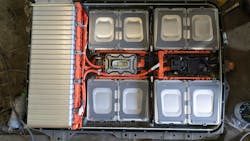Master Cell Balancing to Enhance EV Performance
This article is part of the TechXchange: EV Battery Management.
Members can download this article in PDF format.
What you’ll learn:
- Why cell balancing matters for EV performance.
- How cell conditions can be monitored.
- Different methods of cell balancing.
- The potential role of a battery-management system in addressing these challenges.
While advanced manufacturing and ever-improving process controls are helping to increase uniformity among the cells going into batteries of every kind, variation is still a fact of life and one that normal serial circuit duty cycles only exacerbate (cell balancing is less of a concern in parallel connections). At issue, of course, are the many consequences of cell imbalance, ranging from reduced efficiency in charge and discharge cycles to actual failure.
In applications such as electric vehicles (EVs), cell balancing has emerged as an important design challenge. That’s because balancing the state of cells tends to increase the capacity and life of both cells individually and battery packs in general. Specifically, the amp-hour capacity of a series battery pack is critically influenced by the lowest cell capacity in the assembly.
In a typical battery assembly composed of multiple connected cells, the voltage will vary for each cell. This can be considered from a number of perspectives. For instance, the measured voltage of individual cells often varies considerably from an ideal value, namely the voltage of the whole series pack divided by the number of cells. In practice, individual cells will indicate a higher or lower voltage due to differences in state of charge (SOC) and their internal resistance.
Determining State of Charge
Cell voltage is a good indicator of SOC, but it will not yield useful results when a cell is under load or connected to other cells. There are other ways of establishing SOC, such as current-based and combined voltage- and current-based measurements.
Current measurements, conducted over time from a state of full discharge, can be helpful but are subject to the impact of cumulative measurement errors. A method combining current and voltage measurement also provides insight into cell condition, but it can only be performed when cells aren’t in use. Some of the more sophisticated and more accurate ways to assess cell health involve injecting AC (e.g., AC impedance testing) or DC voltage into the battery assembly and measuring cell voltage.
Additional factors such as battery temperature are also helpful in assessing cell health. Ultimately, none of these methods are perfect since the actual electrochemical state of the cell can’t be directly determined.
Given the uncertainty about SOC, when charging is applied to the whole assembly, some cells will not get fully charged and other may tend to get overcharged. This can reduce the service life of those cells and could even lead to overheating or explosion, a condition termed “thermal runaway.” This may damage not just the battery, but surrounding equipment, property, and people.
Conversely, when discharging, cells falling below a minimum voltage can also present a problem and risk similar damage if the process is allowed to continue.
Cell balancing prevents the problem during either charging or discharging. There are two forms of cell balancing; three if you count doing nothing as an option.
Passive Cell Balancing
Passive cell balancing is less passive than it sounds and isn’t the equivalent of doing nothing, Rather, passive cell balancing involves having a resistor attached to each cell with a switching mechanism in place. The resistor dissipates energy and brings the power level in each cell down to the same level. Yes, it produces balance, but it’s not a very elegant solution to the problem and essentially leads to bringing each cell’s SOC down to the level of the weakest cell in the battery as a whole.
Active Cell Balancing
Taking things up a notch, active balancing attempts the much more complex task of moving energy from cells exhibiting higher SOC to those exhibiting lower SOC. Therefore, the SOC becomes more uniform and higher than with passive balancing. This helps ensure that all cells can be brought up to the highest state of charge and discharged most efficiently.
There are many potential routes to active cell balancing, including DC-DC converters, capacitors, resistors, and inductors. Cost, duty cycles, and many other factors can be part of the design decisions. The methods also may vary depending on factors such as SOC conditions. Thus, an effective system often requires more than one approach to deliver good efficiency across a charge-discharge cycle.
Digging Deeper into Cell Balancing
Cell balancing, as described above, is a natural first reaction to a fairly obvious problem. But to what extent has lack of cell balancing been a real factor in limiting or reducing EV performance, and in what way?
A recent article in the journal Green Energy and Intelligent Transportation revealed what researchers found when they attempted to answer that question through a sophisticated circuit simulation and testing using realistic, real-world duty cycles. Specifically, they modeled the dynamics of individual battery cells through an equivalent circuit model (ECM) and found that results seemed to show a fairly simplistic view of the system worked sufficiently well to provide a basis for cell balancing.
More specifically, their conclusion was that cell capacity was by far the most determinative factor influencing EV range. The implication of their finding is that relatively simple cell balancing may be a kind of “sweet spot” where the benefits and costs are proportional.
The authors also mentioned that some see the need for active balancing as being greater when more cells are involved, particularly greater than 24 V with lithium-ion cells.
Of course, each vehicle and each engineering challenge will benefit from a fresh look and an understanding of the duty cycles and performance requirements.
Bringing it Together with Battery Management
Battery-management systems (BMS) are a means to combine all of these key functions as effectively as possible and they’re commercially available, including in the form of dedicated ICs.
A BMS should be judged on its ability to accurately assess SOC under a range of conditions to implement balancing safely and efficiently, and to accomplish all of this reliably and at a reasonable cost.
Read more articles in the TechXchange: EV Battery Management.
References
Introduction to Cell Balancing (video).
“Impact of battery cell imbalance on electric vehicle range,” Science Direct.
About the Author

